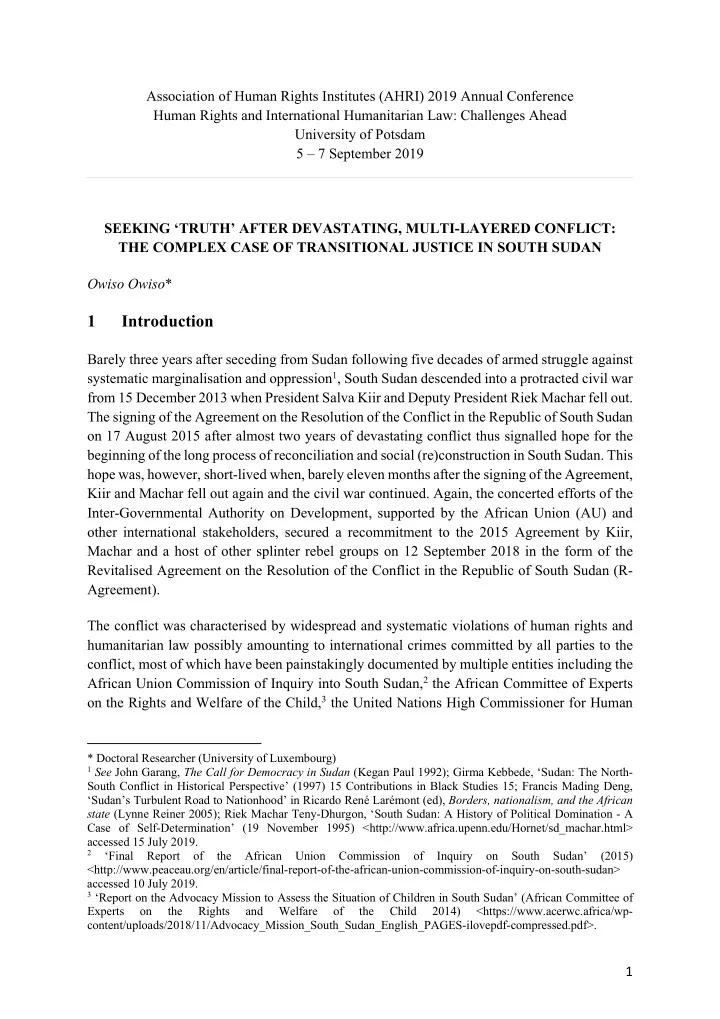

Association of Human Rights Institutes (AHRI) 2019 Annual Conference Human Rights and International Humanitarian Law: Challenges Ahead University of Potsdam 5 – 7 September 2019 SEEKING ‘TRUTH’ AFTER DEVASTATING, MULTI-LAYERED CONFLICT: THE COMPLEX CASE OF TRANSITIONAL JUSTICE IN SOUTH SUDAN Owiso Owiso * 1 Introduction Barely three years after seceding from Sudan following five decades of armed struggle against systematic marginalisation and oppression 1 , South Sudan descended into a protracted civil war from 15 December 2013 when President Salva Kiir and Deputy President Riek Machar fell out. The signing of the Agreement on the Resolution of the Conflict in the Republic of South Sudan on 17 August 2015 after almost two years of devastating conflict thus signalled hope for the beginning of the long process of reconciliation and social (re)construction in South Sudan. This hope was, however, short-lived when, barely eleven months after the signing of the Agreement, Kiir and Machar fell out again and the civil war continued. Again, the concerted efforts of the Inter-Governmental Authority on Development, supported by the African Union (AU) and other international stakeholders, secured a recommitment to the 2015 Agreement by Kiir, Machar and a host of other splinter rebel groups on 12 September 2018 in the form of the Revitalised Agreement on the Resolution of the Conflict in the Republic of South Sudan (R- Agreement). The conflict was characterised by widespread and systematic violations of human rights and humanitarian law possibly amounting to international crimes committed by all parties to the conflict, most of which have been painstakingly documented by multiple entities including the African Union Commission of Inquiry into South Sudan, 2 the African Committee of Experts on the Rights and Welfare of the Child, 3 the United Nations High Commissioner for Human * Doctoral Researcher (University of Luxembourg) 1 See John Garang, The Call for Democracy in Sudan (Kegan Paul 1992); Girma Kebbede, ‘Sudan: The North- South Conflict in Historical Perspective’ (1997) 15 Contributions in Black Studies 15; Francis Mading Deng, ‘Sudan’s Turbulent Road to Nationhood’ in Ricardo René Larémont (ed), Borders, nationalism, and the African state (Lynne Reiner 2005); Riek Machar Teny-Dhurgon, ‘South Sudan: A History of Political Domination - A Case of Self-Determination’ (19 November 1995) <http://www.africa.upenn.edu/Hornet/sd_machar.html> accessed 15 July 2019. 2 ‘Final Report of the African Union Commission of Inquiry on South Sudan’ (2015) <http://www.peaceau.org/en/article/final-report-of-the-african-union-commission-of-inquiry-on-south-sudan> accessed 10 July 2019. 3 ‘Report on the Advocacy Mission to Assess the Situation of Children in South Sudan’ (African Committee of Experts on the Rights and Welfare of the Child 2014) <https://www.acerwc.africa/wp- content/uploads/2018/11/Advocacy_Mission_South_Sudan_English_PAGES-ilovepdf-compressed.pdf>. 1
Rights, 4 the United Nations Commission on Human Rights in South Sudan, 5 the UN Special Rapporteur on the Human Rights of internally Displaced Persons 6 and civil society organisations. In order to deal with the legacy of the conflict, the R-Agreement provides a transitional justice roadmap for South Sudan which includes proposals for the creation of the Commission for Truth, Reconciliation and Healing (the Commission), the Compensation and Reparation Authority and the Hybrid Court for South Sudan (Hybrid Court). The objective of this paper is to examine the potential of the Commission to contribute towards sustainable transitional justice solutions in South Sudan, based on contemporary standards and practice of transitional justice. The paper adopts (i) a historical approach in order to understand the context of truth-seeking in South Sudan and history’s influence on the R-Agreement’s transitional justice provisions, and (ii) descriptive and analytical approaches in examining the proposed design and operation of the Commission. The paper also draws inspiration from truth-seeking experiences in other countries and explores possibilities for learning. Notably, South Sudan is still restive and as such, the analysis in this paper is set against the background of a society caught in the uncertain and ambiguous state between conflict and post-conflict. Therefore, while exploring its key objective, the paper also grapples with the complex question of when a society can be considered to be ‘ripe’ 7 for transitional justice intervention. 2 Locating the ‘right to truth’ in international law 2.1 The general obligation to respect and ensure rights and to provide effective remedy Violations committed during violent conflict generally fall within the purview of international human rights law and international humanitarian law as these are often violations of international obligations of the concerned state arising from the state’s commitment to international human rights and humanitarian law instruments. Generally, international human rights instruments impose an obligation on state parties to respect and ensure the rights and fundamental freedoms guaranteed therein. Specifically, Article 2 of the International Covenant on Civil and Political Rights (ICCPR) obligates a state party ‘to respect and to ensure to all individuals within its territory and subject to its jurisdiction the rights recognized in the present Covenant.’ Similarly, the African Charter on Human and Peoples’ Rights (African Charter) uses the phrase ‘to give effect’ 8 as well as the words ‘ensure’, ‘protect’ and ‘respect’ in its formulation of various rights and freedoms and in referring to the obligations of state parties. 4 ‘Report of the United Nations High Commissioner for Human Rights’ (United Nations Human Rights Council 2015) A/HRC/28/49. 5 ‘Report of the Commission on Human Rights in South Sudan’ (United Nations Human Rights Council 2017) A/HRC/34/63; ‘Report of the Commission on Human Rights in South Sudan’ (United Nations Human Rights Council 2018) A/HRC/37/71; ‘Report of the Commission on Human Rights in South Sudan’ (United Nations Human Rights Council 2019) A/HRC/40/69. 6 ‘Report of the Special Rapporteur on the Human Rights of Internally Displaced Persons’ (United Nations Human Rights Council 2016) A/HRC/26/33/Add.3. 7 Adapted from William Zartman’s theory of ripeness in conflict resolution ( See for example William Zartman, ‘Ripening Conflict, Ripe Moment, Formula and Mediation’ in Diane Bendahmane and John McDonald (eds), Perspective on Negotiation: Four Case Studies and Interpretations: The Panama Canal Treaties, the Falkland/Malvinas Islands, the Cyprus Dispute, Negotiating Zimbabwe's Independence Foreign Service Institute, U.S. Department of State 1986). 8 African Charter on Human and Peoples’ Rights, art 1. 2
Recommend
More recommend